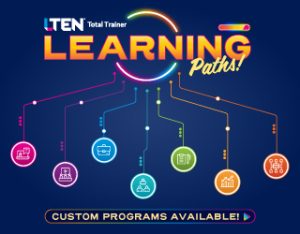
CONNECTIONS – By Lola Gershfeld, Psy.D
Emotional connections can foster cohesive team environments
Even in a forward thinking industry like life sciences training, conflicts arise. Learners expect more than they might receive, stakeholders can get too deep in the weeds and even partner relationships can face strain at times.
Imagine this scenario – it’s not really about life sciences, but then again it is.
A customer walks into a store, asking about custom-printed shirts. He wants a specific size with “Maui” written on it. Unfortunately, his size is unavailable. He appears displeased and irritated.
The educator tries to explain the restocking process, mentioning that they might receive new stock on Friday but can’t confirm the specific size and color. The customer is still displeased and asks to speak with someone more knowledgeable. The educator signals the manager.
Upon arrival, the manager firmly states that they don’t have the shirt and explains the store’s process using jargon that confuses the customer. The customer’s frustration grows, and the educator observes the manager’s defensive stance, later learning of previous similar issues.
The manager, attempting to resolve the situation, walks away to fetch another shirt, but this only escalates the customer’s frustration. The customer becomes more agitated, demanding reports and criticizing the manager, eventually putting his hand in front of the manager’s face in frustration.
Feeling overwhelmed, the manager decides to remove himself from this situation and walks away to the back office. The customer is left furious, and the educator is shocked and confused.
This scenario illustrates a classic pursue-and-withdraw cycle. The customer, feeling unheard, pursues aggressively, while the manager, feeling overwhelmed, withdraws. Left unaddressed, such cycles create lasting damage to customer relationships and team morale.
Emotional Connection in Conflict Resolution
The educator immediately recognizes the pursue-and-withdraw cycle — the customer’s aggressive pursuit in response to feeling unheard and not valued and the manager’s withdrawal response from feeling overwhelmed. Attachment theory suggests that when people lose their connection, they become anxious or avoidant to deal with the disconnect.
Recognizing this dance, the educator addresses the cycle and helps the customer and the manager regain their emotional balance using emotional connections:
- Deescalate: The educator validates the emotions of the customer and manager and aligns with each of their experiences, spending time listening and empathizing without trying to convince them otherwise. This validation helps each person feel heard and understood.
- Fear of not being valued often activates attachment needs. By addressing the powerful emotions and reassuring them of their value, the educator helps to reduce the customer’s agitation and reengages the manager, deescalating the cycle.
- Restructure: The educator slows down the conversation by being emotionally accessible, responsive and engaged without judgment, criticism or blame. Using validation, reflection and reframing, the educator creates bonding moments with the customer and the manager separately, affirming their value, which helps to regain their emotional balance.
Focusing on the moment-to-moment process, the educator starts to shape their realities the way a dancer follows the music. It helps the customer to leave the store with a sense of care, value and connection to the store, the employees and the brand. - Stabilizing the Team: After the customer has left, the educator addresses the relational aspect of the team, organizing the interaction that happened between the customer and the manager, outlining the negative cycle and processing emotions that occurred for those who observed the interaction.
By focusing on validating their experiences, the educator helps to pull the team together, creating new responses, reminding of the ways to exit the cycle and ways they can respond to one another proactively, maintaining their emotional connection.
Emotion moves individuals to action and communicates to others, thereby organizing the dance within the team, and between employees and customers. Using emotional connections, the educator was able to create safety, validate each person’s emotional experience, recognize their stances in the interaction and shift the cycle that can integrate and balance their sense of self and their relationship.
The Impact of Emotional Connection
When the customer left the store, he felt more balanced and cared for. Using validation, reassurance and support, the educator helped everyone to be there for one another, holding space, validating and accepting the power emotions. This approach not only helped deescalate the conflict but it also helped to foster a sense of loyalty and trust within the team relationship.
The manager returned to the floor more balanced and less isolated. He was then able to hear the educator’s experience and validate her feelings, as she felt alone and worried when he left her with the customer.
The team felt more connected and stronger together. The educator helped them understand the cycle better without lecturing the manager or criticizing the customer. Recognizing the attachment needs of each party involved resulted in a new, more satisfying workplace experience, promoting secure bonding and connection.
Moments of conflict are opportunities for relationship repair. Each time a team navigates vulnerability together, their bond gets stronger. Understanding how to foster such deep conversations leads to a supportive and connected culture.
Conclusion
Emotional connection is crucial for addressing conflicts and fostering a cohesive team environment. By recognizing the negative cycle and understanding the steps in the process, the educator moves the team from a negative cycle of conflict to a positive cycle of interaction, ensuring everyone feels heard, valued and connected. This builds attachment rituals and a strong bond, creating resilience, supportive culture and outstanding customer service.
 Lola Gershfeld, Psy.D., is CEO and Organizational Psychologist for EmC Leaders. Email her at lola@emcleaders.com or connect through https://www.linkedin.com/in/lolagershfeld/.
Lola Gershfeld, Psy.D., is CEO and Organizational Psychologist for EmC Leaders. Email her at lola@emcleaders.com or connect through https://www.linkedin.com/in/lolagershfeld/.









